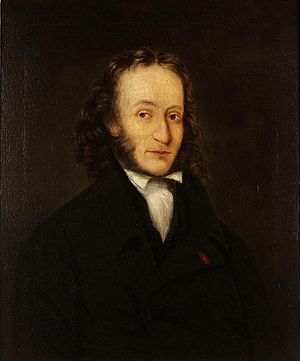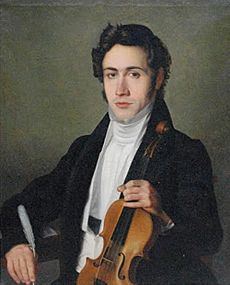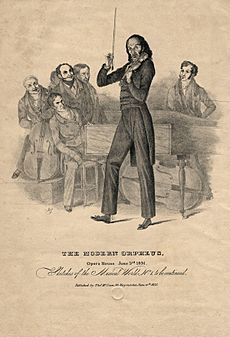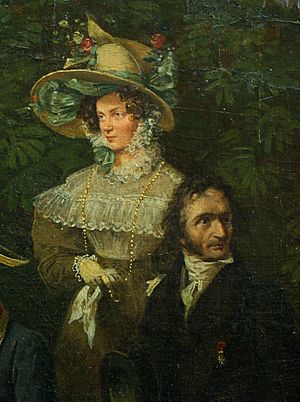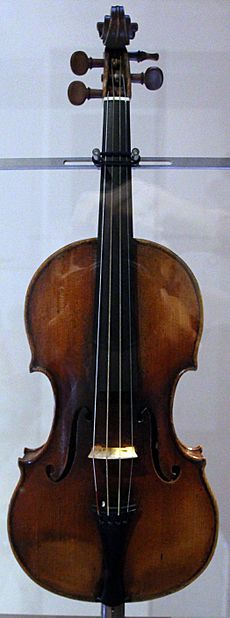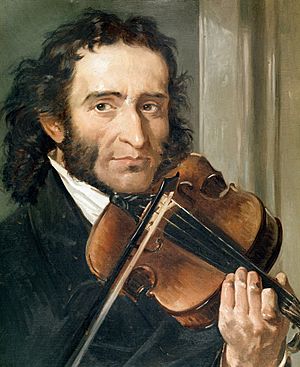Niccolò Paganini facts for kids
Niccolò Paganini (born October 27, 1782 – died May 27, 1840) was a famous Italian violin player and composer. He was known as the greatest violin virtuoso (a highly skilled musician) of his time. Paganini helped shape how the violin is played today. His 24 Caprices for Solo Violin Op. 1 are some of his most famous pieces. They have inspired many other well-known composers.
Biography
Early Life and Musical Start
Niccolò Paganini was born in Genoa, Italy, on October 27, 1782. He was the third of six children. His father, Antonio, played the mandolin and taught Niccolò when he was five. By age seven, Niccolò began learning the violin.
His amazing musical talent was quickly noticed. He received many scholarships to help pay for violin lessons. Young Paganini studied with local violin teachers, but he quickly became better than them.
Paganini and his father then went to Parma to find better teachers. One teacher, Alessandro Rolla, was so impressed that he sent Paganini to his own teacher, Ferdinando Paer. Though Paganini did not stay long with these teachers, they helped shape his music writing style.
Starting His Career
In 1796, French forces entered northern Italy, including Genoa. The Paganini family moved to their country home for safety. During this time, Paganini became very good at playing the guitar. He loved playing it for himself and close friends, but not usually in public concerts. He later called the guitar his "constant companion" on his tours.
By 1800, Paganini and his father moved to Livorno. Paganini played concerts there, and his father worked in shipping. In 1801, at age 18, Paganini became the main violinist for the Republic of Lucca. He also earned money by playing music on his own. He became famous as a violinist, but also for his love of gambling.
In 1805, Lucca became part of France under Napoleon. The area was given to Napoleon's sister, Elisa Baciocchi. Paganini became a violinist for Elisa's court and gave private lessons to her husband. In 1807, Elisa became the Grand Duchess of Tuscany, and her court moved to Florence. Paganini went with them, but he left in late 1809 to play music on his own again.
Becoming a Traveling Star
For the next few years, Paganini toured around Parma and Genoa. He was very popular there, but not yet well known across Europe. His big break came in 1813 with a successful concert at La Scala in Milan. This concert helped him get attention from other important musicians in Europe.
His concert tours were limited to Italy for a few more years. In 1827, Pope Leo XII gave Paganini a special honor called the Order of the Golden Spur. His fame then spread across Europe. He started a concert tour in Vienna in August 1828. He visited major cities in Germany, Poland, and Bohemia, ending in Strasbourg in February 1831. After this, he toured Paris and Britain.
People praised his amazing playing skills and how he showed them off. Besides his own music, Paganini also played changed versions of pieces by other composers. His travels also let him meet famous guitar players like Ferdinando Carulli and Mauro Giuliani. However, he still preferred to play the guitar privately.
Later Years and Health Challenges
Throughout his life, Paganini often had health problems. Doctors today think he might have had conditions like Marfan syndrome or Ehlers–Danlos syndrome. His busy concert schedule and expensive lifestyle also affected his health. In 1834, in Paris, he was treated for tuberculosis. He recovered fairly quickly, but after that, his career often faced delays due to various health issues. These problems ranged from common colds to feeling very sad, lasting for days or months.
In September 1834, Paganini stopped his concert career and went back to Genoa. He spent his time publishing his music and violin methods. He also taught a few students, but they did not find him very helpful. In 1835, Paganini returned to Parma to work for Marie Louise, Napoleon's second wife. He was supposed to reorganize her court orchestra, but he had disagreements and his plans were never finished.
His Final Years and Burial
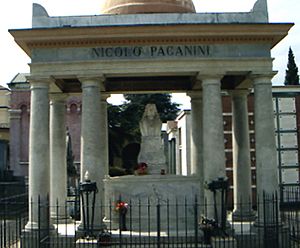
In 1836, Paganini tried to open a casino in Paris, but it failed quickly. This left him with no money. He had to sell his personal belongings, including his musical instruments, to pay off his debts. By Christmas of 1838, he left Paris for Marseille, then traveled to Nice, where his health got worse.
Paganini died on May 27, 1840, at age 57, from internal bleeding. Because he died without a priest present, and due to rumors about him, the Church at first would not allow him a Catholic burial in Genoa. It took four years and an appeal to the Pope before his body was allowed to be moved to Genoa, but it was still not buried. His body was finally buried in 1876 in a cemetery in Parma. In 1893, a violinist named František Ondříček convinced Paganini's grandson to allow a viewing of the body. After this, Paganini's body was moved to a new cemetery in Parma in 1896.
Personal Life
Paganini had many relationships, but he was most serious with a singer named Antonia Bianchi. They met in Milan in 1813 and performed concerts together. They had a son, Achille Ciro Alessandro, born on July 23, 1825. Their relationship ended around April 1828. Paganini took Achille on his European tours, and Achille stayed with his father until his death. Achille was very important in arranging his father's burial years later.
Throughout his career, Paganini also became good friends with composers Gioachino Rossini and Hector Berlioz. Rossini and Paganini met in Bologna in 1818. In 1821, Paganini met Rossini again in Rome and even stepped in to conduct Rossini's opera Matilde di Shabran when the original conductor suddenly died. Rossini was very grateful for Paganini's help.
Paganini met Berlioz in Paris in 1833. Paganini asked Berlioz to write a piece for him. He was not completely happy with the resulting piece, Harold en Italie, and never performed it himself. However, Paganini often called Berlioz the "new Beethoven" and gave him large sums of money later in his life. Both Paganini and Berlioz loved playing the guitar and used it in their music. Paganini even gave Berlioz a guitar, which they both signed.
Playing Style
Musical Instruments
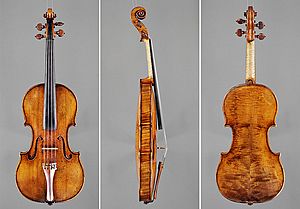
Paganini owned several excellent string instruments. One famous story is about how he got his favorite violin. When Paganini was a teenager in Livorno, a rich businessman lent him a violin made by the master craftsman Giuseppe Guarneri for a concert. The businessman was so amazed by Paganini's playing that he refused to take the violin back. This violin became known as Il Cannone Guarnerius ("The Cannon of Guarnieri") because of its strong and clear sound.
Other instruments Paganini owned included violins by Antonio Amati and Nicola Amati, and several Stradivarius violins. He also had violas and cellos by famous makers. One of his guitars, which he gave to Berlioz, was made by Grobert of Mirecourt, France. This guitar is now on display in the Musée de la Musique in Paris. Paganini also owned a guitar by Gennaro Fabricatore that he refused to sell, even when he had money problems.
Violin Techniques
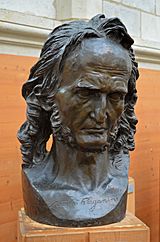
The Israeli violinist Ivry Gitlis once called Paganini a "phenomenon" because of his unique playing. While some of Paganini's techniques existed before him, most violinists at the time focused on playing notes perfectly in tune and using the bow well. Arcangelo Corelli (1653–1713) was important for making the violin a solo instrument, not just part of an orchestra. Other violinists like Antonio Vivaldi and Giuseppe Tartini also wrote music that demanded more from violinists. However, new violin techniques developed slowly. Fast finger movements and special bowing were often seen as unusual and not encouraged.
Much of Paganini's playing was influenced by two violinists: Pietro Locatelli and August Duranowski. When Paganini was studying in Parma, he found Locatelli's 24 Caprices. These pieces, published in the 1730s, were technically very new and had been mostly forgotten. Around the same time, Durand became famous for using harmonics (high, clear sounds) and pizzicato (plucking the strings with the left hand). Paganini was impressed by Durand's new ideas and showmanship. Paganini helped bring these violin techniques back into use, and they are now common in music.
Another special thing about Paganini's violin playing was his amazing flexibility. He had unusually long fingers and could play three octaves across four strings with one hand. This was an incredible feat, even by today's standards. His seemingly unnatural ability might have been due to Marfan syndrome, a condition that affects connective tissue.
Compositions
Paganini wrote his own music mainly to play in his concerts. All his works greatly changed how the violin was played. His 24 Caprices were likely written between 1805 and 1809. During this time, he also wrote most of his solo pieces, duos, trios, and quartets for the guitar, either alone or with strings.
Many of his variations, like Le Streghe and The Carnival of Venice, were composed or first played before his big European tour. His six violin concertos were written between 1817 and 1830.
Paganini's music was very creative with techniques. He greatly expanded the range of sounds the violin could make. He often imitated sounds of different instruments and animals. One piece, Il Fandango Spanolo (The Spanish Dance), had funny imitations of farm animals. Another solo piece, Duetto Amoroso, used the violin to show the sounds of lovers.
Some people, like Eugène Ysaÿe, felt Paganini's music lacked complex layers of sound. However, Yehudi Menuhin suggested this might be because Paganini used the guitar (instead of the piano) to help him compose. The orchestra parts in his concertos were often simple and mainly supported the solo violinist. This style was similar to other Italian composers of his time.
Paganini's "La Campanella" and the A minor Caprice (No. 24) have inspired many composers. These include Franz Liszt, Robert Schumann, Johannes Brahms, and Sergei Rachmaninoff. All of them wrote their own variations based on these famous works.
Legacy and Influence
Inspired Musical Works
Many famous musical pieces have been inspired by Paganini's compositions. Some notable examples include:
- Franz Liszt – Six Grandes Études de Paganini for solo piano (1851). These are difficult arrangements of 5 caprices, including the 24th, and "La Campanella."
- Yngwie Malmsteen – Uses Paganini's Violin Concerto No. 4 in his song "Far Beyond the Sun."
- Nathan Milstein – Paganiniana, a set of variations based on Paganini's 24th Caprice.
- Robert Schumann – Studies after Caprices by Paganini, Op. 3 (1832; piano).
- Steve Vai – "Eugene's Trick Bag" from the movie Crossroads. This is based on Caprice No. 5.
- The Caprice No. 24 in A minor has been used by many other composers. Famous examples are Brahms's Variations on a Theme of Paganini and Rachmaninoff's Rhapsody on a Theme of Paganini.
Memorials and Honors
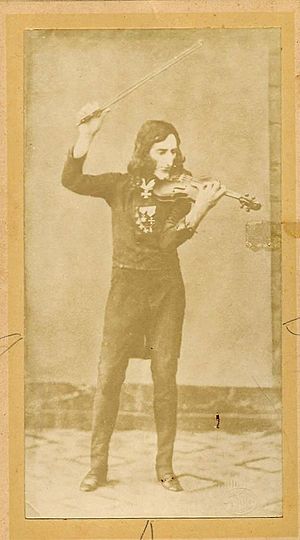
The Paganini Competition (Premio Paganini) is an international violin competition. It was started in 1954 in his hometown of Genoa and is named in his honor.
In 1972, the Italian government bought a large collection of Niccolò Paganini's original music papers. They are now kept at the Biblioteca Casanatense in Rome.
In 1982, the city of Genoa asked for a list of all Paganini's music. This list was put together by Maria Rosa Moretti and Anna Sorrento, and his works are now known by the abbreviation "MS."
A minor planet named 2859 Paganini was discovered in 1978 by Soviet astronomer Nikolai Chernykh. It was named after him.
Fake Photograph
No real photographs of Paganini are known to exist. However, in 1900, an Italian violin maker named Giuseppe Fiorini created a famous fake photo (a daguerreotype) of the celebrated violinist. It was so well done that many people believed it was real for a long time.
Portrayals in Movies and TV
Paganini has been played by several actors in movies and TV shows:
- Stewart Granger in the 1946 movie The Magic Bow.
- Klaus Kinski in Kinski Paganini (1989).
- David Garrett in The Devil's Violinist (2013).
In the 1982 Soviet TV series Niccolo Paganini, the musician was played by Armenian actor Vladimir Msryan. The series shows Paganini's relationship with the Roman Catholic Church. Another actor, Armen Dzhigarkhanyan, played a made-up rival. The series includes some myths about Paganini. One famous scene shows his enemies trying to ruin his violin before a concert. All the strings except one break during the show. But Paganini, not giving up, continues to play on just one string. In real life, Paganini sometimes broke strings on purpose during his shows to impress the audience even more! He would carefully weaken them so they would break while he played.
See also
 In Spanish: Niccolò Paganini para niños
In Spanish: Niccolò Paganini para niños


